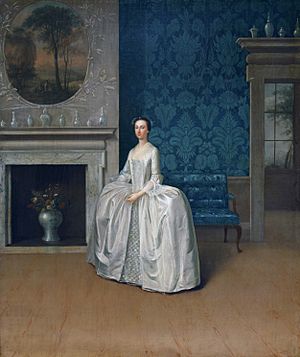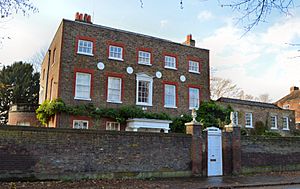Lady Juliana Fermor Penn facts for kids
Quick facts for kids
Lady Juliana Fermor Penn
|
|
|---|---|

"Lady Juliana Penn (née Fermor)" (1752) by Arthur Devis, from the Philadelphia Museum of Art
|
|
| Born |
Juliana Fermor
May 21, 1729 |
| Died | November 20, 1801 |
| Nationality | English |
| Known for | wife of Thomas Penn, mother of John Penn and Granville Penn |
Lady Juliana Penn (born Fermor; May 21, 1729 – November 20, 1801) was an important English woman. She was the wife of Thomas Penn, who was a proprietor of the Colony of Pennsylvania. This meant he owned and helped manage the colony in America. Lady Juliana helped her husband with his work, especially as he got older. She also wrote letters to important leaders in the early United States, like John Adams.
Contents
Early Life of Lady Juliana
Juliana Fermor was born in 1729. Her family lived at Easton Neston in Northamptonshire, England. She was the fourth daughter of Thomas Fermor, 1st Earl of Pomfret and Henrietta Louisa Jeffreys.
Marriage and Family Life
Juliana Fermor married Thomas Penn on August 22, 1751. She was much younger than her husband. Before their marriage, Thomas Penn was a Quaker, a type of Christian. After they married, he regularly went to Anglican church services. The Penn family lived at Stoke Park, Buckinghamshire in England.
Lady Juliana and Thomas Penn had eight children together. Sadly, four of their children died when they were babies or very young. Their daughter Juliana also passed away at age 19 during childbirth.
Helping with the Colony
In the early 1770s, Thomas Penn's health started to get worse. Their sons, John Penn and Granville Penn, were still very young. Because of this, Lady Juliana became very involved in managing the Colony of Pennsylvania. She helped keep things running smoothly.
She wrote many letters to the governor of Pennsylvania, John Penn, and other important officials in the colony. They talked about maps and other important papers needed to manage the land.
Challenges During the Revolution
In March 1775, Lady Juliana's husband, Thomas Penn, passed away. She was put in charge of his personal property. Soon after, the American Revolutionary War began. This made things very difficult for her family's money and land in America.
Lady Juliana wrote often to American leaders. She asked them to consider her family, who she felt were "innocent and suffering." She also worked with William Baker, who helped manage her husband's estate. They were very interested in land surveys in the Wyoming Valley. They hoped for a good outcome for their family's land claims.
Important people visited Lady Juliana in England. For example, the Reverend Jacob Duché visited her in 1783. John Jay, who was helping to negotiate the Treaty of Paris (1783) that ended the war, also wrote to her. He kept her updated on the peace talks.
Lady Juliana Penn passed away in 1801 at the age of 72. She died at Beaufort House in Ham, England. She was buried with her husband and children at Stoke Poges.
Lady Juliana's Legacy
Lady Juliana Penn was painted by famous artists. She posed for three portraits by Sir Joshua Reynolds in 1755, 1764, and 1767. Another portrait of her from 1752, painted by Arthur Devis, is now at the Philadelphia Museum of Art.
In 1763, a library in Lancaster, Pennsylvania was named the Juliana Library Company. It was named after Lady Juliana Penn because she donated books to their collection.
Her son, John Penn, had a special memorial urn created for her by James Wyatt. This urn is located in the beautiful Stoke Poges Memorial Gardens. These gardens were once part of the Penn family's estate at Stoke Park.


